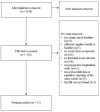Social class and the risk of dementia: A systematic review and meta-analysis of the prospective longitudinal studies
- PMID: 35815546
- PMCID: PMC10642219
- DOI: 10.1177/14034948221110019
Social class and the risk of dementia: A systematic review and meta-analysis of the prospective longitudinal studies
Abstract
Background: The association between belonging to a disadvantaged socio-economic status or social class and health outcomes has been consistently documented during recent decades. However, a meta-analysis quantifying the association between belonging to a lower social class and the risk of dementia has yet to be performed. In the present work, we sought to summarise the results of prospective, longitudinal studies on this topic.
Methods: We conducted a systematic review and meta-analysis of prospective, longitudinal studies measuring the association between indicators of social class and the risk of all-cause/Alzheimer's dementia. The search was conducted in four databases (Medline, Embase, Web of Science and PsychInfo). Inclusion criteria for this systematic review and meta-analysis were: (a) longitudinal prospective study, (b) aged ⩾60 years at baseline, (c) issued from the general population, (d) no dementia at baseline and (e) mention of social class as exposure. Exclusion criteria were: (a) study of rare dementia types (e.g. frontotemporal dementia), (b) abstract-only papers and (c) articles without full text available. The Newcastle-Ottawa scale was used to assess the risk of bias in individual studies. We calculated the overall pooled relative risk of dementia for different social class indicators, both crude and adjusted for sex, age and the year of the cohort start.
Results: Out of 4548 screened abstracts, 15 were included in the final analysis (76,561 participants, mean follow-up 6.7 years (2.4-25 years), mean age at baseline 75.1 years (70.6-82.1 years), mean percentage of women 58%). Social class was operationalised as levels of education, occupational class, income level, neighbourhood disadvantage and wealth. Education (relative risk (RR)=2.48; confidence interval (CI) 1.71-3.59) and occupational class (RR=2.09; CI 1.18-3.69) but not income (RR=1.28; CI 0.81-2.04) were significantly associated with the risk of dementia in the adjusted model. Some of the limitations of this study are the inclusion of studies predominantly conducted in high-income countries and the exclusion of social mobility in our analysis.
Conclusions: We conclude that there is a significant association between belonging to a social class and the risk of dementia, with education and occupation being the most relevant indicators of social class regarding this risk. Studying the relationship between belonging to a disadvantaged social class and dementia risk might be a fruitful path to diminishing the incidence of dementia over time. However, a narrow operationalisation of social class that only includes education, occupation and income may reduce the potential for such studies to inform social policies.
Keywords: Age; Alzheimer’s disease; aging; dementia; education; income; meta-analysis; neighbourhood; occupation; social class; social determinants of health; social inequalities; social status; systematic review; wealth.
Conflict of interest statement
Declaration of conflicting interestsThe authors declared no potential conflicts of interest with respect to the research, authorship and/or publication of this article.
Figures



Similar articles
-
Home treatment for mental health problems: a systematic review.Health Technol Assess. 2001;5(15):1-139. doi: 10.3310/hta5150. Health Technol Assess. 2001. PMID: 11532236
-
Interventions targeted at women to encourage the uptake of cervical screening.Cochrane Database Syst Rev. 2021 Sep 6;9(9):CD002834. doi: 10.1002/14651858.CD002834.pub3. Cochrane Database Syst Rev. 2021. PMID: 34694000 Free PMC article.
-
Electronic cigarettes for smoking cessation.Cochrane Database Syst Rev. 2021 Sep 14;9(9):CD010216. doi: 10.1002/14651858.CD010216.pub6. Cochrane Database Syst Rev. 2021. Update in: Cochrane Database Syst Rev. 2022 Nov 17;11:CD010216. doi: 10.1002/14651858.CD010216.pub7. PMID: 34519354 Free PMC article. Updated.
-
Electronic cigarettes for smoking cessation.Cochrane Database Syst Rev. 2022 Nov 17;11(11):CD010216. doi: 10.1002/14651858.CD010216.pub7. Cochrane Database Syst Rev. 2022. Update in: Cochrane Database Syst Rev. 2024 Jan 8;1:CD010216. doi: 10.1002/14651858.CD010216.pub8. PMID: 36384212 Free PMC article. Updated.
-
Taxane monotherapy regimens for the treatment of recurrent epithelial ovarian cancer.Cochrane Database Syst Rev. 2022 Jul 12;7(7):CD008766. doi: 10.1002/14651858.CD008766.pub3. Cochrane Database Syst Rev. 2022. PMID: 35866378 Free PMC article.
Cited by
-
Socioeconomic inequalities linked to the transitioning to neurocognitive disorders and mortality.Sci Rep. 2024 Nov 1;14(1):24690. doi: 10.1038/s41598-024-74125-w. Sci Rep. 2024. PMID: 39487192 Free PMC article.
-
Social determinants of health and risk of dementia among older men and women: A 12-year cohort study in Australia.Alzheimers Dement. 2025 Mar;21(3):e70065. doi: 10.1002/alz.70065. Alzheimers Dement. 2025. PMID: 40110677 Free PMC article.
-
mHealth Intervention for Dementia Prevention through lifestyle Optimisation (MIND-PRO) in a primary care setting: protocol for a randomised controlled trial in people with low SES and/or migration background.BMJ Open. 2025 Feb 3;15(2):e088324. doi: 10.1136/bmjopen-2024-088324. BMJ Open. 2025. PMID: 39900419 Free PMC article.
-
Impact of Childhood Adversity on Late-Life Cognition in Older Puerto Rican Adults.J Gerontol B Psychol Sci Soc Sci. 2025 Mar 12;80(4):gbae199. doi: 10.1093/geronb/gbae199. J Gerontol B Psychol Sci Soc Sci. 2025. PMID: 39673803
-
Educational inequalities in dementia-related mortality using a multiple cause of death approach and their contribution to life expectancy differences in Spain.Sci Rep. 2025 Jul 23;15(1):26838. doi: 10.1038/s41598-025-10079-x. Sci Rep. 2025. PMID: 40702031 Free PMC article.
References
-
- Stern Y, Gurland B, Tatemichi TK, et al.. Influence of education and occupation on the incidence of Alzheimer’s disease. JAMA 1994;271:1004–10. - PubMed
-
- Evans DA, Hebert LE, Beckett LA, et al.. Education and other measures of socioeconomic status and risk of incident Alzheimer disease in a defined population of older persons. Arch Neurol 1997;54:1399–405. - PubMed
-
- Fritsch T, McClendon MJ, Smyth KA, et al.. Effects of educational attainment and occupational status on cognitive and functional decline in persons with Alzheimer-type dementia. Int Psychogeriatr 2002;14:347–63. - PubMed
-
- Karp A, Kareholt I, Qiu C, et al.. Relation of education and occupation-based socioeconomic status to incident Alzheimer’s disease. Am J Epidemiol 2004;159:175–83. - PubMed
-
- Wilson RS, Scherr PA, Hoganson G, et al.. Early life socioeconomic status and late life risk of Alzheimer’s disease. Neuroepidemiology 2005;25:8–14. - PubMed
Publication types
MeSH terms
LinkOut - more resources
Full Text Sources
Medical

